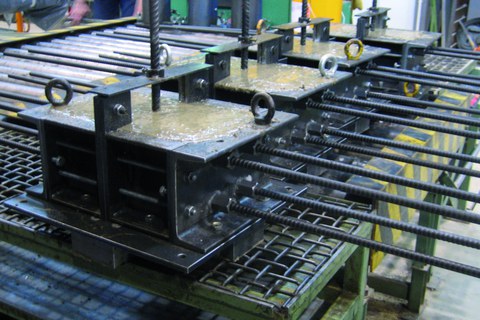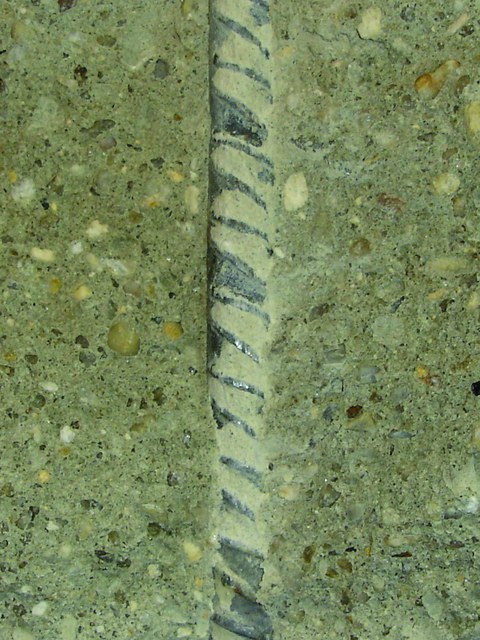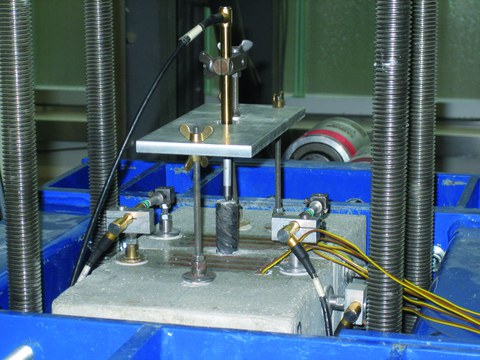Effect of the transverse tension and fatigue on bond between concrete and reinforcing steel
Table of contents
Project data
| Titel | Title Die Auswirkungen der Kombination von Querzug und Ermüdungsbeanspruchung auf den Verbund zwischen Beton und Bewehrungsstahl | The effects of the combination of transverse tension and fatigue on bond between concrete and reinforcing steel Förderer | Funding Deutsche Forschungsgemeinschaft DFG Zeitraum | Period 04.2007 – 03.2009 (1st period of funding) 11.2009 – 03.2012 (2nd period of funding) Leiter | Project Manager Prof. Dr.-Ing. Dr.-Ing. E.h. Manfred Curbach Bearbeiter | Contributor Dr.-Ing. Alexander Lindorf |
Report in the yearbook 2011
Bond Fatigue Under Transverse Tension

Casting of the specimens
The main goal of this research project is the specific analysis of the bond behaviour between reinforcement and concrete under combined loading resulting from fatigue and transverse tension. The background is formed by reinforced concrete elements such as bridge decks of steel-concrete composite bridges, which show a biaxial load bearing behaviour under not predominantly monotonic loading.
The investigations for normal strength and high performance concrete were conducted on pull-out specimens with one longitudinal crack along the reinforcing bar caused by transverse tension. The experimental program included high cyclic tests with four different load cycles and varying longitudinal crack widths up to one million load cycles. The comparison of the individual load conditions was carried out by means of the slip development between reinforcing bar and concrete depending on the number of load cycles. A definite dependency of the bond strength on the transverse tension could be observed. The wider the longitudinal crack due to transverse tension, the more the slip increased. The slip was also affected by the mean stress, the stress range and the concrete strength. The analytical description of the slip development according to Model Code 90 could be modified considering the test results.
Based on the prediction of the slip development, S-N curves for bond fatigue could be deduced. Since the exceeding of a certain relative displacement has severe consequences for the bond between steel and concrete, the S-N curves were set up as normalised S-N curves based on a tolerable slip increase of 0.1 mm. These S-N curves can be set in direct relation to the S-N curves for steel fatigue and simplify creating constant life diagrams, due to the normalised quasi fatigue strength values at a limit number of load cycles of one million load cycles. From these diagrams, which are needed for design purposes, the valid stress ranges in dependency to the longitudinal crack width can be read. It becomes clear that the bond fatigue strength, due to an existing longitudinal crack, gains in importance in comparison to the fatigue strength of the reinforcing steel. Therefore, it has to be questioned, to what extent the previous procedure of separate verifications for reinforcing steel and concrete meets the requirements of this problem.
Report in the yearbook 2010
Bond Fatigue under Transverse Tension

Bond area (C30/37)
Numerous factors impact the bond behaviour between reinforcing steel and concrete. Loads due to fatigue and transverse tension are some of them. These load scenarios can occur separately or, e.g. concerning composite steel and concrete bridges, at the same time. Large composite steel and concrete bridges are often made of one steel box girder, on which a reinforced concrete bridge deck is applied. The bridge deck is loaded longitudinally with tension within the support area, which leads to cracking along the transverse reinforcement. The webs of the box girder load the transverse reinforcement with tension. While the tensile load remains nearly constant over the bridge’s longitudinal direction due to the high dead loads, the transverse reinforcement is cyclically loaded by vehicle traffic. Therefore, the question how to describe the bond behaviour for one of these reinforcing bars was more important, because in the past, the bond properties have been investigated either for monotonic loads with transverse tension or for pure cyclic loads.
The research project, which started already in 2007, continued this year. While the investigations so far have been conducted with normal strength concrete, the focus is now on concrete with higher strengths. The test program consists of high cyclic pull-out tests with four different stress ranges and three different longitudinal crack widths. By weakening the cross section of the specimen along the pull-out bar, the crack could be predefined. The transverse tensile load that creates the defined crack width is applied through four transverse reinforcing bars, which are cast into concrete in the specimen.
The quality of the bond is evaluated by means of the slip increase between reinforcing bar and concrete depending on the number of load cycles. The results of the tests showed a considerable influence of transverse tension on the bond strength under cyclic loading. The wider the longitudinal crack due to transverse tension, the more the slip increased. The analytical description of the slip increase according to Model Code 90 could be modified by means of the test results. Based on the prediction of the slip development, S-N curves (Wöhler lines) for bond fatigue have been deduced. After completing all tests, fatigue limit diagrams according to Smith shall be developed.
Report in the yearbook 2009
Fatigue of Bond Under Transverse Tension

Slip measuring
Longitudinal cracks. A large number of reinforced concrete structures are exposed to bi-axial load transfer under cyclic loading. Typical examples include industrial structures with reinforced concrete slabs and composite steel and concrete bridges with un-tensioned bridge decks. Heavy equipment loads or heavy vehicular traffic actuates non-monotonic load conditions within the structure’s elements. Tensile stress in the primary load direction causes crack development parallel to transverse reinforcement (i. e., bars). In those cases when cracks appear directly along the rebar, the bond quality of the transverse reinforcement is particularly affected. In 2007 an experimental test program was initiated in order to evaluate the bond behaviour between concrete and ribbed steel bars under repeated load and transverse tension.
Pull-out tests. Pull-out specimens with a longitudinal crack located along reinforcing bars were exposed to repeated pull-out loads. All tests were performed on concrete prisms measuring 300 mm × 160 mm × 160 mm, with a pull-out bar diameter of 16 mm and a bond length of 10 bar diameter. The notched cross-section of the prism guaranteed the location of the longitudinal crack along the pull-out bar. The required transverse tensile load was applied to four transversal steel bars by means of a separate steel frame. Stress ranges were adequately defined to fall within the standards of fatigue limit states for ribbed steel bars. High cyclic tests, of up to one million load cycles, were performed for four different load levels and three different crack widths.
Slip increase. The increase in slip (i. e., slip between steel rebar and concrete) relative to the number of load cycles was taken into account to compare various load conditions. The influence of transverse tension on bond resistance under repeated loading became evident. The wider the longitudinal crack widths resulting from transverse tension were the greater the increase in slip and the sooner bond failure occurred. In some cases, slip development, as given by Model Code 90, led to an underestimation of slip increase as observed in testing.
It was possible to enhance the model with regard to the crack widths tested. Initial S-N-curves for bond fatigue were derived for fatigue design based on slip development predictions. Pull-out tests for normal strength concrete were completed in 2009. A comparable study with high strength concrete will follow as part of the next step.
